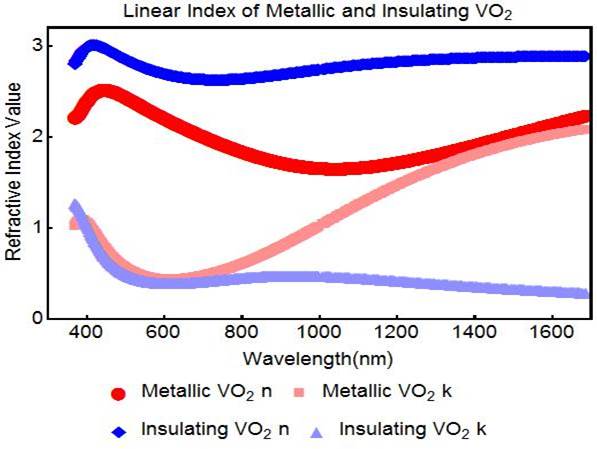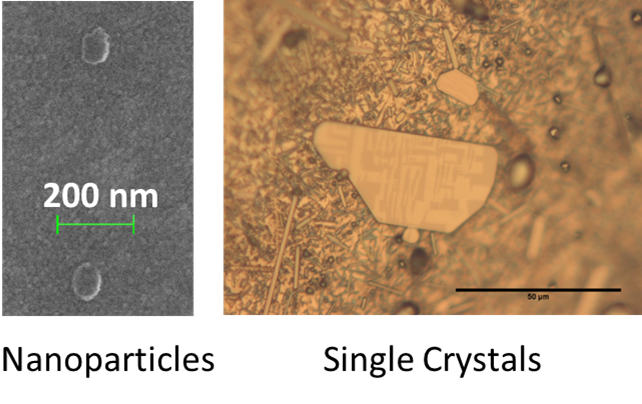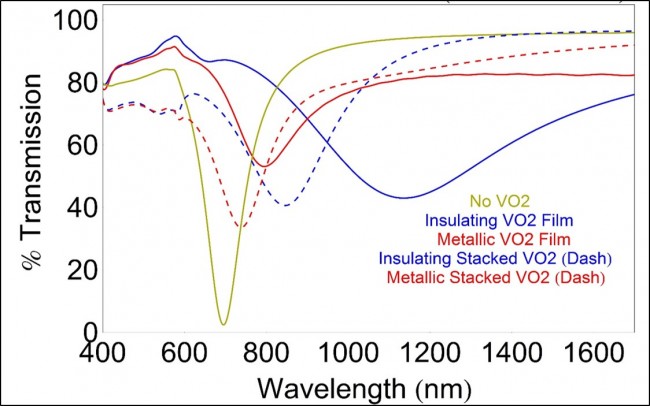Research
Below is some of my work during graduate school on active plasmonics, combining gold nanoparticles with the phase change material vanadium dioxide. For a full description of my graduate work including atomic hydrogen sensing with gold+VO2, phase coexistence of VO2 single crystals using plasmonics and scanning scattering near field optical microscopy (s-SNOM), and fabrication developments, see my dissertation.
Vanadium Dioxide (VO2) – Phase Change Material
 Vanadium dioxide (VO2) is a phase change material with reversible structural (monoclinic to rutile) and electronic (insulator to metal) phase transitions. The transitions often occur simultaneously and occur around 67 degrees C for pure VO2, though the transition temperature can be shifted via doping or strain. The phase change can be induced through heating, ultrafast laser excitation, high electric field, or strain. This phase change creates a large change in the real and imaginary parts of the refractive index of VO2, as can be seen in the left graphic. The contrast increases as the wavelength is increased into the near-IR.
Vanadium dioxide (VO2) is a phase change material with reversible structural (monoclinic to rutile) and electronic (insulator to metal) phase transitions. The transitions often occur simultaneously and occur around 67 degrees C for pure VO2, though the transition temperature can be shifted via doping or strain. The phase change can be induced through heating, ultrafast laser excitation, high electric field, or strain. This phase change creates a large change in the real and imaginary parts of the refractive index of VO2, as can be seen in the left graphic. The contrast increases as the wavelength is increased into the near-IR.
One method to detect the VO2 phase transition is to measure the transmission or reflection from the material while the VO2 is switched. Below, switching is achieved through heating and cooling the sample. A clear decrease in transmission is observed as temperature is increased and the VO2 switches from insulating to metallic, and transmission increases to the original value as the sample is cooled back to room temperature.
In addition to thin films, VO2 can be fabricated as nanoparticles and single crystals as seen above via scanning electron and polarized optical microscopy respectively.
VO2+Plasmonics
VO2 shifts and broadens the dipole plasmon resonance mode of the Au disk because VO2 changes the local dielectric environment of the Au disk. Since VO2’s dielectric function changes as it undergoes the phase transition, the plasmon resonance changes when the underlying VO2 film is below the phase transition temperature (blue line above) compared to when the VO2 film is above the phase transition temperature (red line above). Using less VO2 (underlying VO2 nanodisk instead of film) results in narrower resonances (blue and red dashed lines above) but a smaller shift in plasmon resonance when VO2 undergoes the phase transition (switches between blue and red dotted lines).
Switchable Electromagnetically Induced Transparency in Au:VO2 Nanoarrays
Plasmon-induced transparency (PIT) is a classical analogue of electromagnetically induced transparency where a spectrally broad and a spectrally narrow plasmon resonance interact. This interaction can yield a sharp, narrow increase in transmission referred to as a transparency window. Here we demonstrate a novel method of reversibly and actively modulating the plasmon resonance of multi-element plasmonic nanostructures which exhibits PIT by using the phase transition in vanadium dioxide. VO2 modulates the near-field dielectric environment of metal nanostructures via its insulator-to-metal transition (IMT). The IMT shifts the plasmonic response of the metal nanostructure. We design these hybrid structures using three-dimensional, finite-difference time-domain (FDTD) Lumerical simulations and fabricate them with a combination of high-resolution electron-beam lithography and VO2 deposition. To measure the modulation, we use visible spectroscopy and observe the spectral change in the location of the PIT window as we heat the VO2 to thermally induce the phase transition. As the IMT can also be induced optically, these hybrid structures could be useful nanoscale switches or sensors.





©2026 Vanderbilt University ·
Site Development: University Web Communications